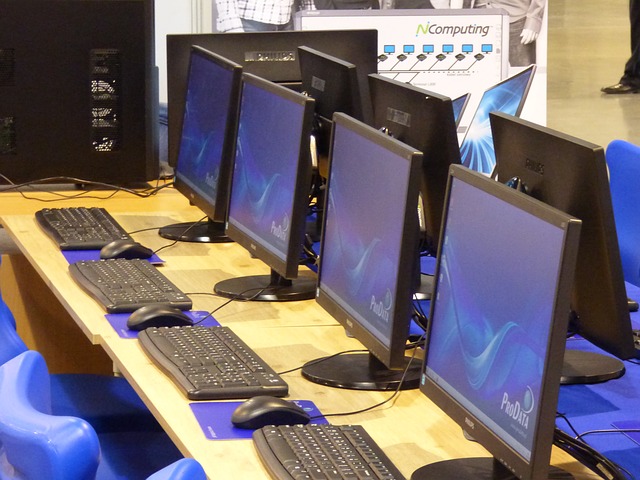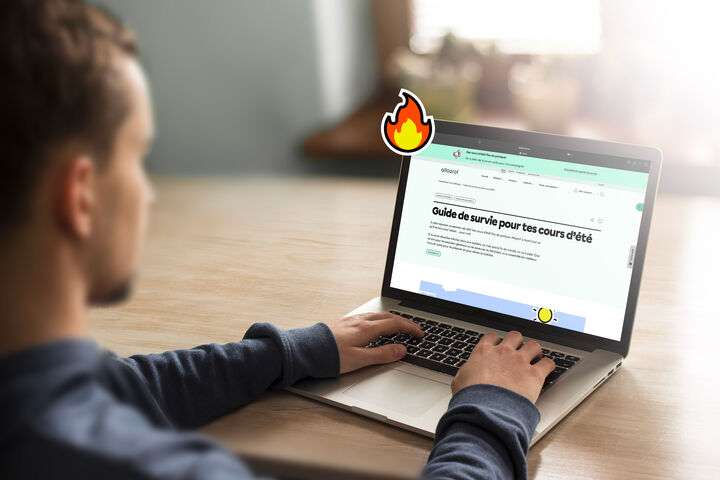Lors du dernier colloque de l’AQUOPS, l’enseignant Patrick Poulin a présenté plusieurs outils technologiques pertinents pour les élèves de ses cours de français au secondaire. Gratuits et collaboratifs pour la plupart, ils ont été rassemblés pour en faciliter la consultation.
Patrick Poulin est enseignant au 1er cycle du secondaire et responsable TIC à l’école des Deux-Rives, à la Commission scolaire de la Beauce-Etchemin. Au cours des dernières années, il a expérimenté une variété d’outils dans sa classe de français. « Il y a 15 ans, on avait peu de choix, commence-t-il. Aujourd’hui, c’est différent. Il faut trouver le temps de s’approprier les outils et de choisir le meilleur. J’ai bâti l’atelier comme j’aurais aimé le recevoir. Ce sera une formule buffet où chacun pourra faire des découvertes. »
Il a servi comme « entrée » les ressources qu’il considère incontournables. Que ce soit Moodle, Google Classroom ou le volet gratuit de ChallengeU, il suggère d’utiliser une plateforme pour y déposer des capsules facilitant l’étude. Parmi les outils de référence, sa préférence va à Antidote, qu’il utilise au TNI. « Ce n’est pas qu’un correcteur, précise-t-il à ses élèves, c’est un copilote. Il fera des propositions et tu décideras si ça fait du sens. » Monsieur Poulin souhaite que ses élèves se fassent confiance, pas nécessairement qu’ils écrivent tout leur texte pour le passer au correcteur à la toute fin. « Je désire qu’ils questionnent leur doutes et utilisent le correcteur et les dictionnaires intégrés au logiciel pour leurs besoins particuliers », ajoute-t-il.
Il suggère également à ses élèves de créer un compte sur Allô prof pour obtenir des résultats en fonction de leur niveau scolaire, de fouiller la « mine d’or » des ressources validées de Carrefour éducation et de consulter la BDL (banque de dépannage linguistique) de l’Office québécois de la langue française. Cette partie de l’atelier a été complétée par ses suggestions d’outils de partage de liens : Pearltrees, Symbaloo et Diigo.
Plusieurs outils utiles ont composé le plat de résistance. « Il existe une multitude de possibilités pour questionner les élèves », observe-t-il. « Il faut y aller selon les goûts et les besoins de chacun. Google Forms et son extension Flubaroo, Socrative et Kahoot figurent parmi ceux qu’il a testés. Ce dernier a d’ailleurs été utilisé pour vérifier qui, des soixante participants présents, arriverait à trouver le plus rapidement la réponse dans le concours @1fauteparjour du projet Voltaire. Climat énergique assuré!
Parmi ses applications de présentation préférées, notons Prezi, PowToon, Voki et Moovly. Dans sa gestion de classe, les impose-il pour la réalisation d’un travail ou laisse-t-il le choix aux élèves? « C’est une bonne question, répond l’enseignant. Il ne faut pas se demander, en tant que professionnel, de connaître à fond tous les outils. Les jeunes se font un plaisir de les enseigner aux autres au TNI. Pour ma part, je présente le projet et je demande aux élèves quel outil ils ont choisi. Sinon, ça ne ferait pas d’eux des élèves autonomes. »
Il propose l’utilisation du grammaticiel, cette application Web qui permet à l’élève de comprendre la grammaire en analysant des phrases. Même s’il y a possibilité de créer un compte par élève (payant), il propose l’utilisation originale de cet outil à l’aide d’un seul compte pour opposer les garçons et les filles dans leur compréhension de la grammaire. Il les invite aussi à utiliser Padlet pour diffuser des liens et Crocodoc pour partager leurs annotations et stratégies en ligne.
Comme « dessert », pour poursuivre la métaphore, M. Poulin a présenté plusieurs ressources en rafale dont Thinglink pour ses nombreuses possibilités au niveau des images actives, Mind42 pour les tempêtes d’idées, Etherpad pour travailler un texte à plusieurs et BAnQ pour son grand inventaire de lecture.
Facebook et Twitter sont utilisés pour le réseautage professionnel de Patrick Poulin (dont ces 30 groupes Facebook à suivre en éducation). Il a expérimenté Edmodo pour les échanges avec ses élèves et ClassDojo pour sa gestion de classe. Il se promet aussi d’explorer ClassCraft prochainement.
Patrick Poulin enseigne le français dans un laboratoire informatique où chaque élève a son ordinateur. Pour lui, la gratuité, l’accès par le Web et la possibilité de coconstruire résument les caractéristiques d’un bon outil. Pourquoi avoir choisi des outils dont l’interface est en anglais? « Oui, je suis un prof de français qui utilise certains outils en anglais », confie-t-il. « C’est certain que je privilégie des outils offrant une interface en français. Cependant, pour certains besoins, nous n’avons pas le choix. »
Pour consulter l’ensemble des ressources proposées par Patrick Poulin lors de cet atelier à l’AQUOPS, consultez : Monurl.ca/atelierticetfrancais






